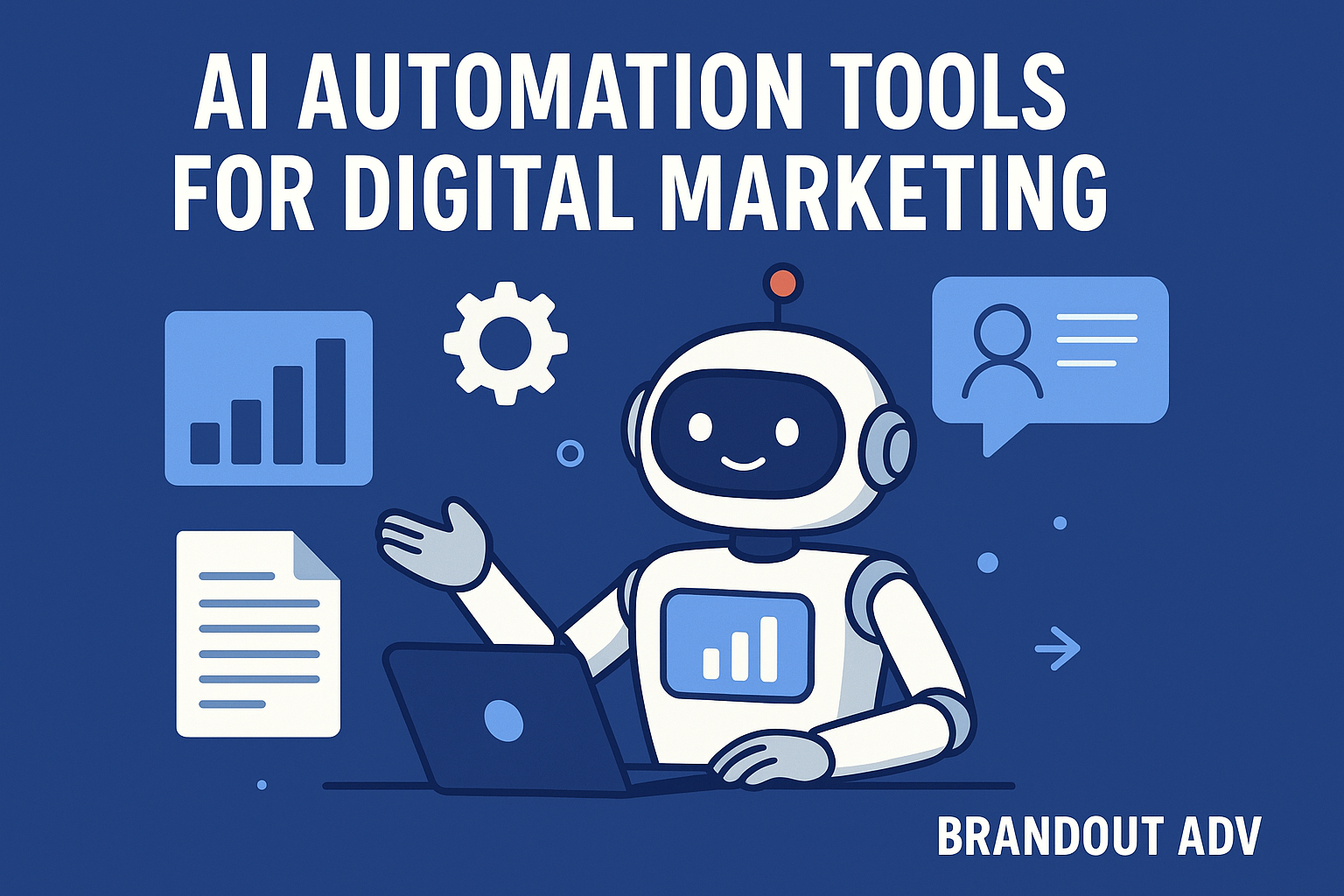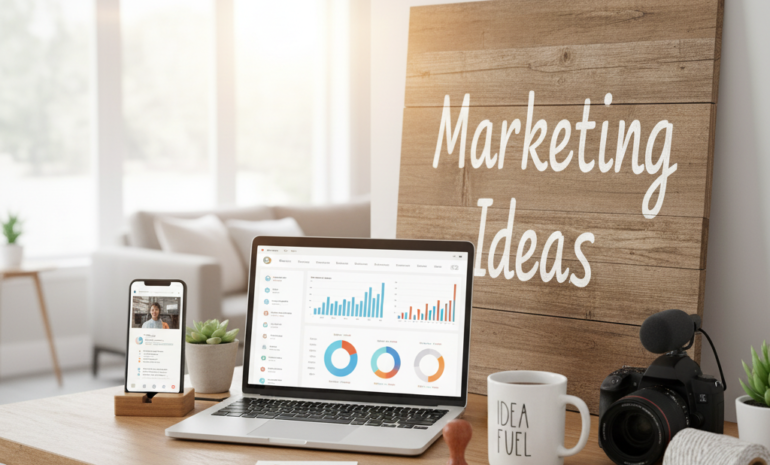Artificial intelligence is no longer experimental. It runs ad campaigns, writes copy, answers customer questions, and pulls reports. For a digital marketing team that needs results without chaos, AI automation tools offer repeatable work, fewer manual errors, and more time to focus on strategy and execution.
This article explains what these tools do, when to use them, and how to implement them without wasting budget or attention.
What are AI automation tools?
AI automation tools are software that use machine learning or rule-based automation to perform or assist with marketing tasks. These tools do not replace humans.
They handle repetitive work, surface insights, generate first drafts, and run tests faster. Human input is still required for creative direction, quality control, and ethical choices.
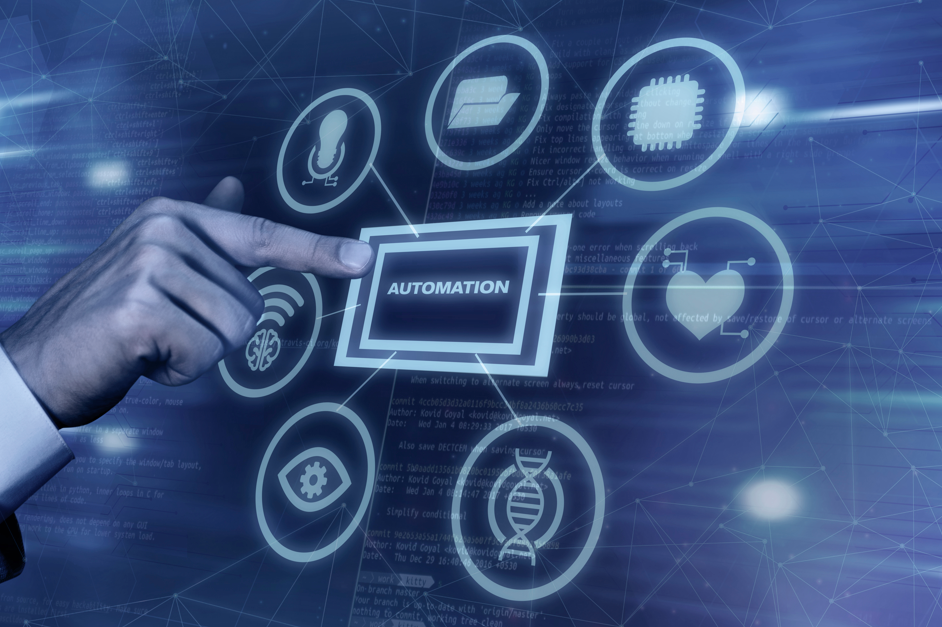
Where does AI help most in digital marketing?
- Campaign setup and optimization: Auto-bidding, budget pacing, audience expansion, and creative testing.
- Content creation: Drafting headlines, ad copy, short articles, and social posts.
- Customer interactions: Chatbots, conversational assistants, and automated email responses.
- Analytics and reporting: Data consolidation, anomaly detection, and automated report generation.
- Personalization at scale: Product recommendations, dynamic landing pages, and segmented messaging.
- Workflow automation: Task routing, alerts, and integration between tools.
Types of AI automation tools and what they do
1. Ad automation and bidding platforms
These tools manage large numbers of campaigns and automatically adjust bids to hit KPIs like CPA, ROAS, or CPL. They remove the need to change bids for dozens of ad sets manually and can pause underperforming creatives.
How to use them
- Start with conservative targets and a learning period of at least one to two weeks.
- Provide clean conversion tracking and consistent attribution windows.
- Monitor creative performance. Automation can’t fix bad creative.
2. Creative and copy generation tools
AI can produce headline options, ad descriptions, and short-form posts quickly. Use these outputs as drafts, not final copies. Human review is mandatory to maintain brand voice and compliance.
How to use them
- Generate multiple variations and run them in low-cost tests.
- Keep a shortlist of best-performing lines and refine them.
- Always check for factual accuracy and tone.
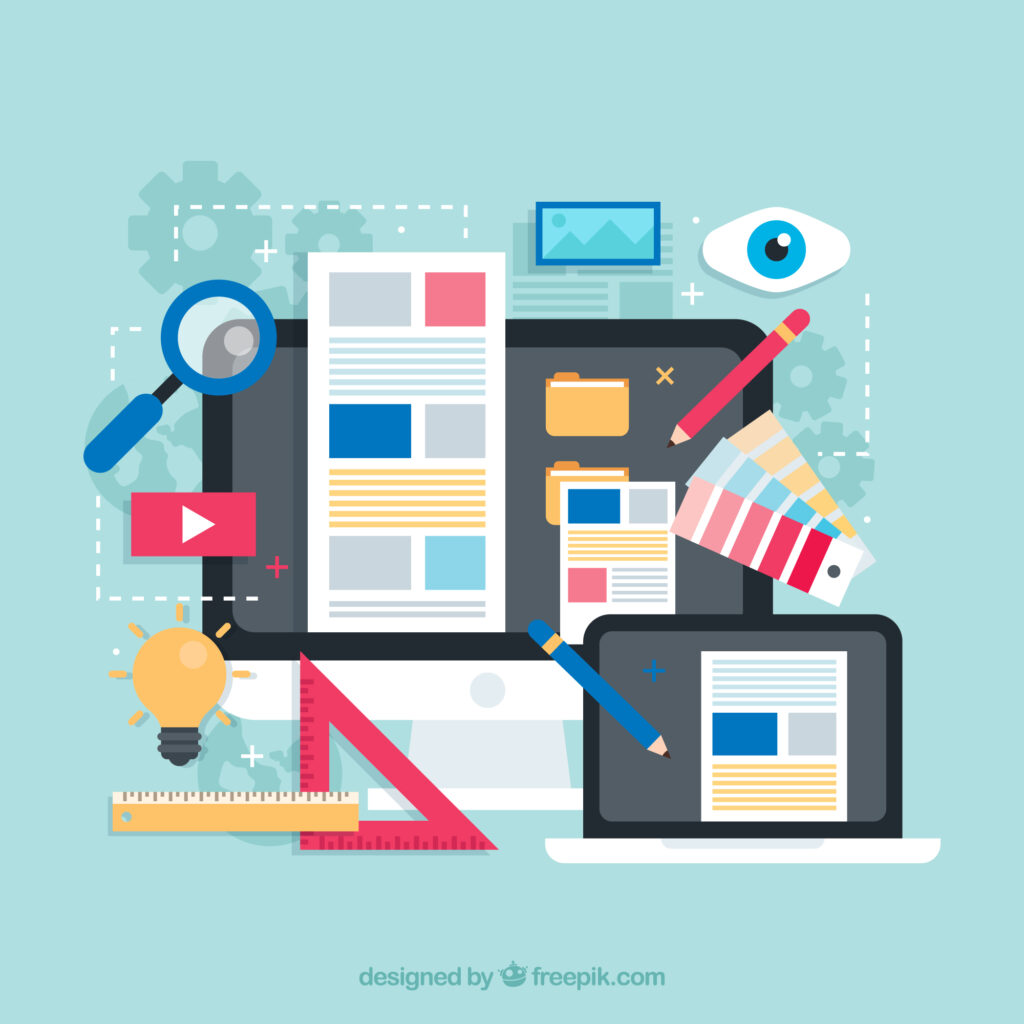
3. Chatbots and conversational AI
Chatbots handle common queries, book appointments, qualify leads, and pass complex issues to humans. When configured well, they reduce first-response time and keep users engaged outside business hours.
How to use them
- Map customer journeys and common questions first.
- Use clear escalation paths to human agents.
- Train the bot on real transcripts to reduce nonsense answers.
4. Email and marketing automation
AI in email marketing automates send time optimization, subject line testing, and automated flows based on user behavior. The goal is higher open rates, better segmentation, and consistent follow-up.
How to use them
- Start with simple flows: welcome series, cart abandonment, and reactivation.
- Use subject line and preheader variants for A/B testing.
- Respect frequency; automation can annoy more than help.
5. SEO and content optimization tools
These tools suggest keywords, generate content briefs, and analyze on-page issues. They can also recommend internal linking and content clusters based on search intent.
How to use them
- Use AI to build outlines, then write or edit to match your brand’s voice.
- Validate keyword suggestions against real search intent.
- Fix technical SEO issues reported by the tool before publishing.
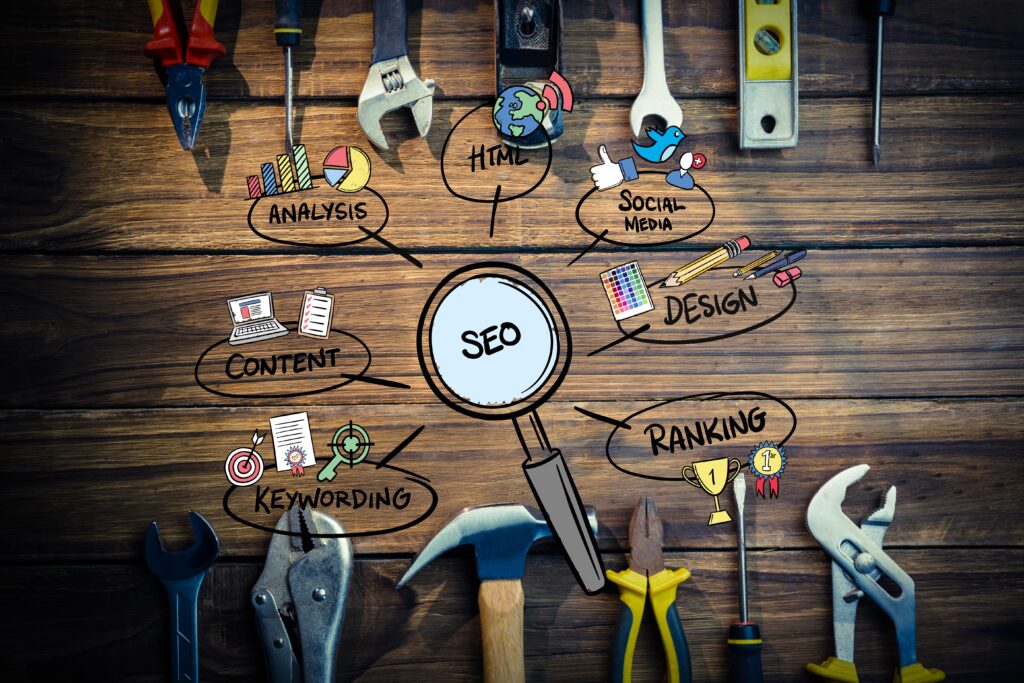
6. Analytics, reporting and anomaly detection
AI can scan data and find signals humans miss, such as sudden drops in conversion or rising costs in a specific audience. Automated reporting saves hours and provides earlier warnings.
How to use them
- Configure thresholds for alerts so you’re not overwhelmed with noise.
- Treat AI findings as hypotheses, then investigate with raw data.
- Use reports to reduce manual weekly tasks.
7. Personalization engines
Personalization tools show different content, offers, or page layouts to different segments automatically. When done well, they improve conversion and average order value.
How to use them
- Define clear segments and goals for each segment.
- Start with one variable, such as the headline or hero image, and measure the impact.
- Avoid over-personalization that feels intrusive.
How to choose the right AI automation tools?
- Match tools to the problem: Don’t buy a full suite for a problem a single script can solve.
- Check data requirements: Many AI tools need good historical data to perform well. If you have little data, start with rule-based automation or invest in tracking first.
- Integration matters: Pick tools that connect to your ad accounts, analytics, and CRM. Poor integration creates manual work instead of removing it.
- Transparent decision-making: Prefer tools that explain why they made a change. Black-box tools are hard to troubleshoot.
- Cost versus benefit: Calculate the monthly cost against the expected time saved or performance improvement. Require a short trial period.
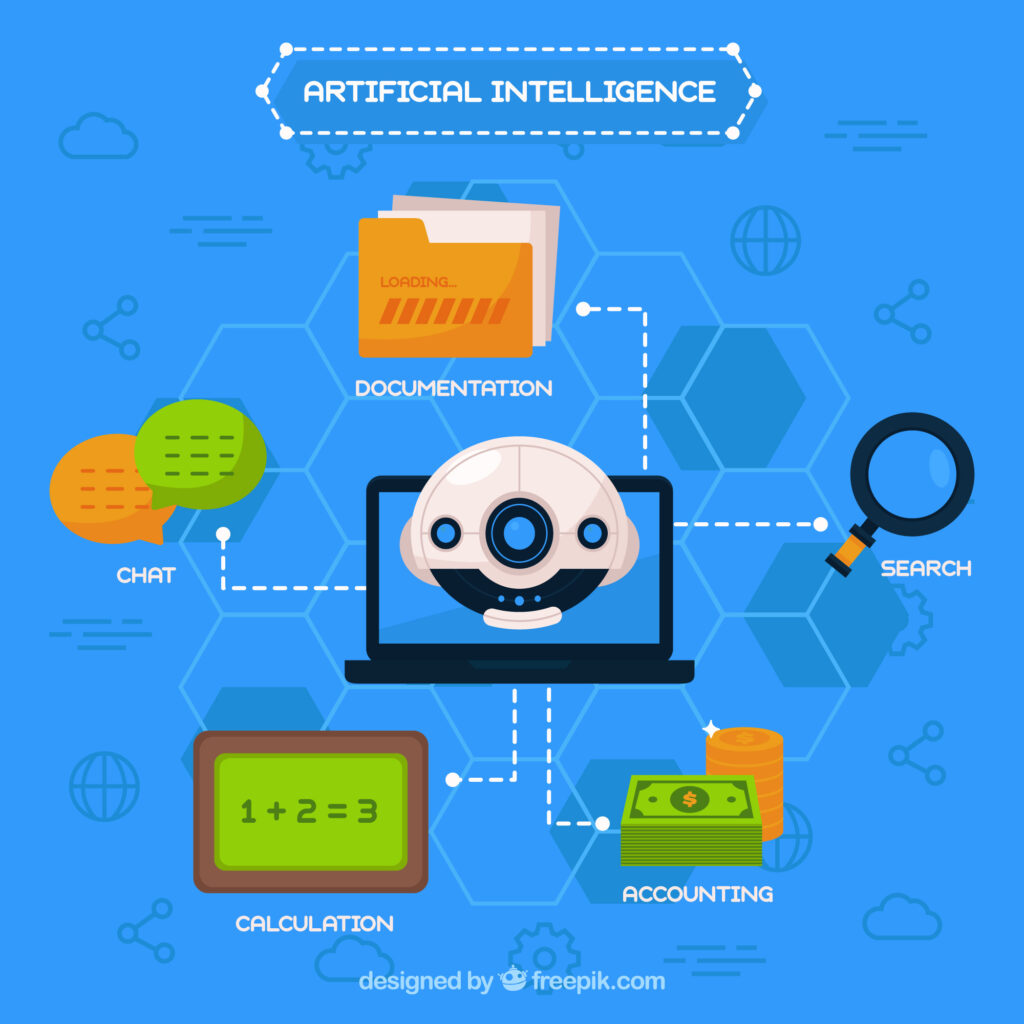
Implementation checklist
- Step 1: Audit data and tracking
Ensure conversions are accurate. AI needs clean signals to optimize correctly. - Step 2: Start small
Run AI in a subset of campaigns or channels. Measure impact before scaling. - Step 3: Use guardrails
Set maximum daily spend, acceptable CPA range, and rules to pause campaigns. - Step 4: Monitor creatives
Automations can scale poor creative quickly. Keep a creative review process. - Step 5: Document changes
Log what the AI changed and why. This helps when reverting decisions. - Step 6: Measure and iterate
Compare performance to a control group and use results to refine strategies.
Common pitfalls and how to avoid them
Blind trust in automation
Problem: Marketers assume the tool is always right. Automation optimizes to the metrics you give it, not to long-term brand health.
Fix: Keep a human in the loop and review long-term KPIs.
Bad data in, bad data out
Problem: Incorrect or duplicate conversions mislead the AI and lead to poor choices.
Fix: Clean your tracking and remove noisy events.
Over-optimization for short-term metrics
Problem: Tools focused on immediate CPA can ignore customer lifetime value.
Fix: Include LTV or retention metrics where possible.
Creative fatigue
Problem: Automation tests many variants but can burn through a creative set quickly.
Fix: Plan a steady creative production schedule and retire low performers.
Privacy and compliance issues
Problem: Some personalization or tracking approaches can break privacy laws.
Fix: Consult legal, anonymize data, and follow consent rules.
Measuring success with AI automation
Keep measurement simple and aligned to business goals. Typical metrics include CPA, ROAS, conversion rate, average order value, and customer acquisition cost.
Also track operational metrics like hours saved and report cadence improvements.
What to compare?
- Control versus AI-managed campaigns
- Pre-automation baseline data
- Cost of tool versus incremental profit or time saved
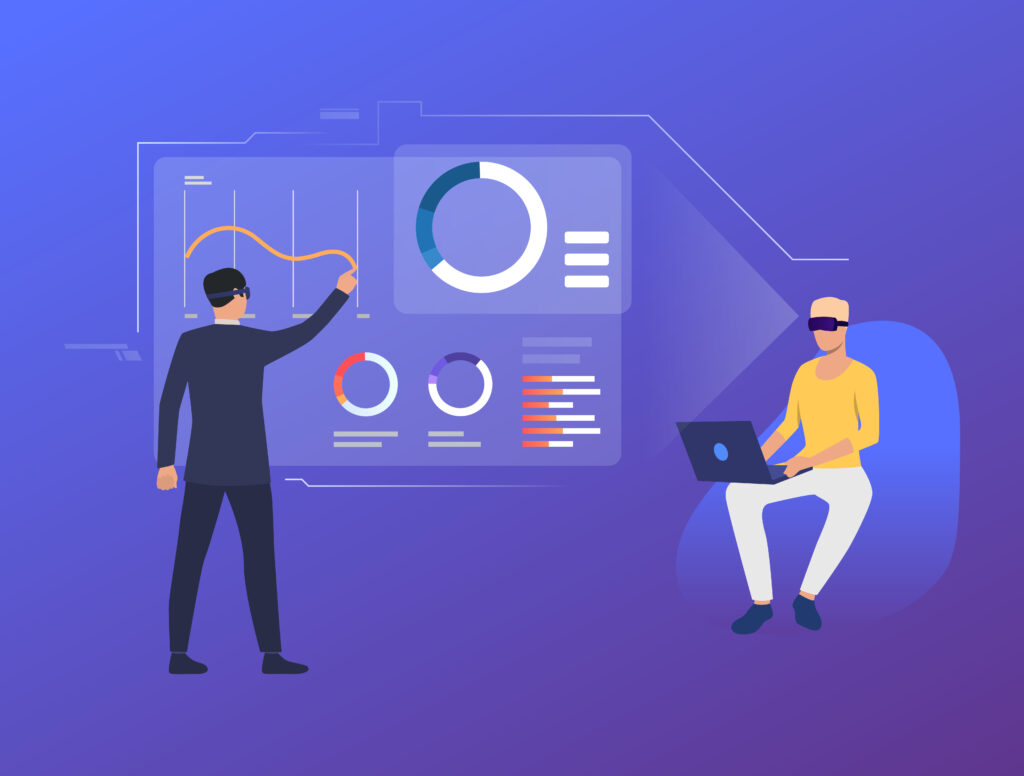
Quick tool categories and examples
These are categories rather than endorsements. Test options that fit your stack.
- Ad automation: automated bidding and budget management.
- Creative AI: headline and copy generation, image suggestion.
- Chat and conversational AI: lead qualification and support.
- Email automation: flows, send-time optimization, subject testing.
- SEO assistants: content briefs, keyword mapping, and technical audits.
- Analytics AI: anomaly detection, forecasting, automated dashboards.
Ethical considerations and data privacy
Using AI responsibly matters. Personalization should respect user privacy and consent. If you process customer data, follow local laws and global standards.
Avoid deceptive personalization tactics. Keep audit logs for automated decisions that affect customers.
Realistic timeline for adoption
- Week 0-2: Audit tracking, pick a single use case, and prepare data.
- Week 3-6: Run pilot with guardrails in place and collect results.
- Month 2-3: Evaluate pilot, refine, and expand to more campaigns.
- Month 4+: Scale across channels and incorporate learnings into standard operating procedures.
Case example – simple pilot plan
Goal: Reduce CPA for search campaigns.
Pilot setup
- Choose three similar campaigns with steady volume.
- Keep one as a control. Assign AI to two campaigns.
- Define the CPA target range and a daily max spend.
- Run for four weeks.
Evaluation
- Compare CPA, conversion volume, and overall spend.
- Check creative performance and audience shifts.
- Decide whether to scale based on consistent gains and no negative impact on LTV.
Checklist for teams before using AI automation
- Clear KPI definitions
- Working conversion tracking
- Responsible person for monitoring
- Guardrails for spend and pause rules
- Creative refresh plan
- Data privacy review
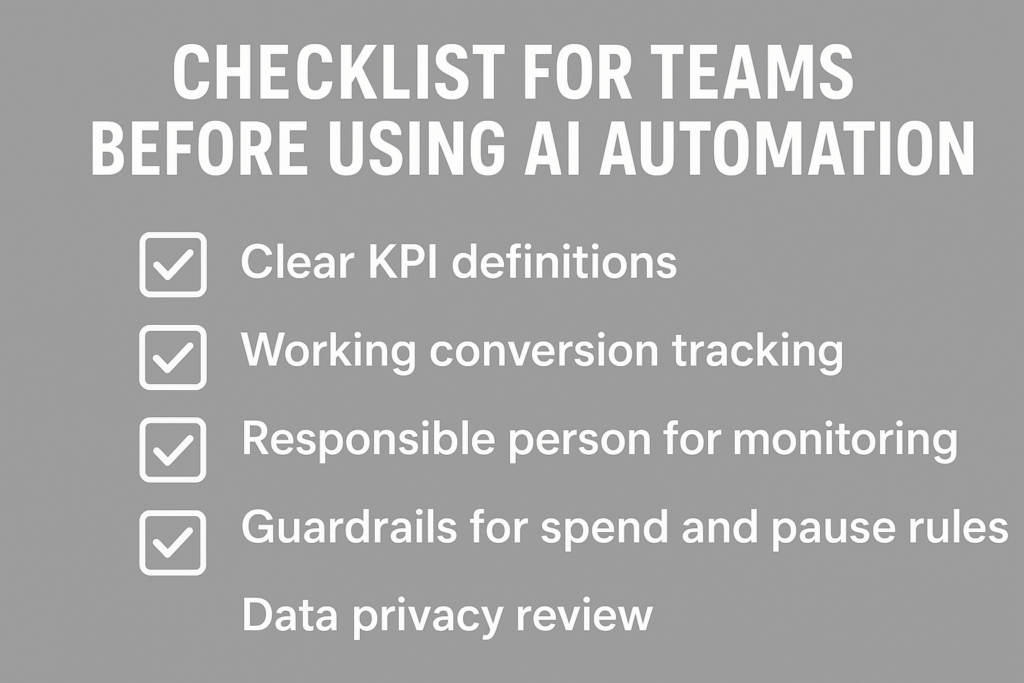
Conclusion and next steps
AI automation tools are powerful when used with discipline. They cut repetitive tasks and help find signals in large data sets. They are not a shortcut for poor strategy or bad creative work. Use them for efficiency, not as a replacement for thoughtful marketing.
If you want a practical next step, Brandout Adv can audit your current tracking, suggest a pilot use case, and set up guardrails so automation improves results without surprises. Contact Brandout Adv to schedule an automation readiness audit and a one-month pilot plan.
Frequently Asked Questions
Do AI automation tools replace human marketers?
No. They handle repetitive tasks and surface insights but still need humans for strategy, creative direction, ethical decisions, and quality control.
How do I choose the right AI automation tool for my business?
Match the tool to your specific problem, ensure it integrates with your existing stack, check data requirements, and test with a small pilot before full rollout.
What are the main benefits of using AI automation in marketing?
Time savings, faster campaign optimization, improved targeting, automated reporting, and better personalization can increase conversions and reduce costs.
What risks should I watch out for with AI automation?
Risks include relying on bad data, over-optimizing for short-term metrics, creative fatigue, and privacy or compliance issues. Use guardrails and regular human oversight to avoid these pitfalls.

